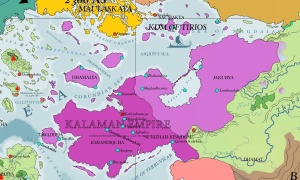High Culture of Kalama
Historians consider the two millennia of time following the Chaos Period and the City-State Period to be the long cultural flowering of the historical deep antiquity of Kalama. Measured roughly from 4,400 AS to 2,450 AS, this period of about 1950 years spans four kingdoms, the Gahashpujani Kingdom, the Pandhauzhi Kingdom, the Neibhu-Yona Kingdom, and the Surizhah Kingdom. Each of these so-called kingdoms is a historial sequence of several related dynasties typically ruling from a common capital. Centered on various cities of splendor on the high Vimalian plateau of Kalama (Corundy), the imperial and commercial influence of the Kalamans Kingdoms reached throughout Vindalia, the islands of the Pallathantic, and the shores of the Memnosian Sea.
In the middle of the fifth millennium before Salmakhamer, the Adamantine Giants invaded Vindalia and Vimalia, bring about an end to the period known as the Kalaman City-States. The defeat and expulsion of the Adamantine Giants brought about the establishment of the Hanumbasha Dynasty, the first of the Gahashpujani Kingdom. The united cities of Kalama were able to defend themselves against invaders and secure the rule of king of Kalama and his bureaucrats. Enduring for four kingdoms, the catastrophes associated with the Cataclysm of the Screeching Maidens hastened the decline of the Surizhah Kingdom and the end of the so-called High Culture of Kalama.
During this great period, Malesggite Civilization, Neptulchi Civilization, and ancient Tirios also flourished. The first major migrations of the Gwenya Tribes remained limited to western Asdauria and had not yet reached the Jaggudorns, Pytharnia, or Vindalia. In the first millennium of this period, Pytharnia suffered the invasion of the Neptultchi (The Coming of the Neptultchi). The Adamantine Giants not only invaded eastern Vindalia, but also prompted the migrations of the Thammazite Tribes in eastern Danona and in Weshif. The Kalaman High Culture period was also simultaneous with the last two millennia of the Mythical Kingdom of Omre, the last centuries of the Elephants Prophets of Zir-Lis-Nan, the orcish Otog-Serai Civilization of northern Danona, and the Zephasian City-State Empire of Kumonaggi.
Gahashpujani Kingdom
4317 AS to 3733 AS (584 years)
- Capital Kathyabrumya
- Hanumbasha Dynasty pre-Kingdom, 4,423 AS to 4,320 AS, (~103 years)
- Tramasthajya Dynasty 4,320 AS to 4,247 AS (~73 years)
- Gahashpujani Dynasty 4,247 AS to 4,151 AS (~96 years)
- Challagahrra Dynasty 4,151 AS to 4,094 AS (~56 years)
- Zhaptuh Dynasty, 4094 AS to 3968 AS, (~156 years);
- Mehrikuna Dynasty, 3968 AS to 3915 AS, (~23 years)
- Drasa Dynasty, 3915 AS to 3733 AS (~182 years)
The Hanumbasha Dynasty (4,423 AS to 4,320 AS, (~103 years)), the dynasty that established what became known as the Gahashpujani Kingdom, successfully dealt with a new onslaught of invasions of Adamantine Giants that disrupted and helped end the city-state period. The leadership and martial prowess of the Hanumbasha rulers re-united Kalama and repelled the giants to the mountains, signaling the beginning of a new golden age. Esabdalite nomads were enlisted as mercenaries to help the Kalamans fight the giants. In addition to liberation from the giants, the Kalaman rulers expanded trade in the Pallathantic and Memnosian Seas, larging exercising hegemony in politics and trade over Malessgite Civilization which also saw a flowering during this great period. The seven dynasties of the Gahashpujani Kingdom were established in Kathyabrumya. The sixth dynasty, the Mehrikuna Dynasty, was propped up by Esabdalite mercenaries who eventually became rulers in the final dynasty, the Drasa Dynasty. The Gahashpujani lasted 584 years (4,317 AS to 3,733 AS) and collapsed due to a series of centaur invasions from the east.
Pandhauzhi Kingdom
3733 AS to 3255 AS (478 years)
- Capital Gampha Shakhuphshi
The five successive dynasties of the Pandauzhi Kingdom ultimately ended in thirty one year interdynastic period that ended with the collapse of the Pandhauzhi Kingdom. The first king of the Ambharaghasha Dynasty established his rule and that of the Kingdom in Gampha Shakhuphshi (Babirrhoksha), a city that lay to the west of the Vimalian Plateau. The interdynastic years are considered part of the Pandhauzhi Kingdom as the main participants were of its last dynasty. During the Ambharaghasha Dynasty, the water wheel was invented in the Valley of Lord Vimal. The antiquity known as Shayarin Zhampha is dated to within the Luhimnauskhu Dynasty. Internal strife is largely credited with the collapse of the Pandhauzhi Kingdom.
Neibhu-Yona Kingdom
3255 AS to 3042 AS (213 years)
- Capital Jhukhaulya (Johaulia)
The Neibhu-Yona Kingdom consisted of two dynasties, the Samankha Dynasty, 3255 AS to 3138 AS, (~117 yrs) and the Jhelumjhahuth Dynasty, 3137 AS to 3042 AS, (~95 yrs). Rebellions and dissensions amid the empire of the latter dynasty helped bring about its end and the collapse of the Neibhu-Yona Kingdom.
Surizhah Kingdom
3042 AS to 2323 AS, (719 years)

The Surizhah Kingdom was the longest lasting of the four Kingdoms and yet possibly the most distressed. Its last rulers experienced the hardships that signaled the end of the cultural brilliance of some two thousand years.The five dynasties of the Surizhah Kingdom ruled from ancient Aturoksha the city that even up to today vies with Johaulia in ancient magnificence. The Surizhah Kingdom dealt with the first waves of the Neptultchi piratical assaults that brought undead zombies to the northern shores of Kshandiguh and other reaches in the Pallathantic Sea. During the Sursaha and Wakhumand Dynasties, scholars gathered original sources and produced still more about the fabled Lords of Light also known as the Lords of Creation whom the ancientest of kings were said to have propitiated. During the Pajatta Dynasty, the sun-cult was established (2666 AS) in the city of Thaulyoksha, (Zamaclë). Around 2370 AS, the ominous Cataclysm of the Screeching Maidens took place, earthquakes and local floods, so called for the Screeching Maidens of Zamaclë who were said to foretell them. The final dynasty, the Uhappha Dynasty, consisted of one ruler who only lasted seven years. King Thuptala of the Uhappha and much of his court were slain in a violent earthquake that shook Aturoksha, bringing his dynasty and the Surizhah Kingdom to an abrupt end. The empire continued to be ruled from Aturoksha during the Tamukh Kingdom, but never truly regained its former magnificence.
Kalaman Bronze Age
- CHALCOLITHIC (Copper Age): 5100 AS to 4200 AS
- EARLY BRONZE: 4200 AS to 3000 AS
- MIDDLE BRONZE: 3000 AS to 2450 AS
- LATE BRONZE: 2450 to 2100 AS
- IRON AGE: 2100 AS to 900 AS
See Also
| This article is a stub. It requires further development by the creator. |

